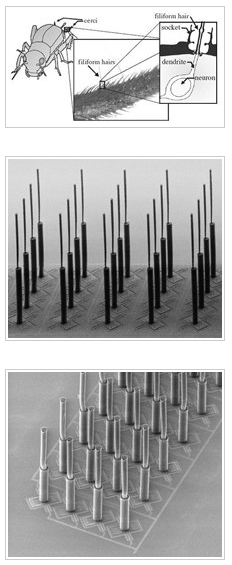Home > Press > Synthetic cricket pricks up its ‘ears’
 |
Abstract:
The tiny hairs on the abdomen of a cricket have inspired researchers at the University of Twente, to make a new type of sensor which is ultra sensitive to air flows. These synthetic cricket hairs can now also be tuned very precisely for a certain range of frequencies: the hairs are 10 times more sensitive in this range. The researchers of the MESA+ Institute for Nanotechnology are presenting these new results in the scientific journal Applied Physics Letters.
Synthetic cricket pricks up its ‘ears’
The Netherlands | Posted on December 13th, 2011Just as you always hear your own name if it is spoken at a busy gathering, these synthetic cricket hairs also suddenly become more sensitive to a specific frequency of air flow. The hair itself does not have to be modified for this, the enhanced sensitivity is achieved by adjusting its spring stiffness electronically.
Biomimicry
The synthetic cricket hair is an example of biomimicry, the hairs on a cricket's abdomen - on the projections known as 'cerci' - form the source of inspiration. These hairs enable the cricket to feel/hear the approach of its enemies and estimate their distance and direction unerringly. These characteristics can be simulated by making a hair that is suspended in a flexible microsystem. The hair is made of polymer SU8, is 0.9 millimetre in length and is thicker at the base than at the top. The smallest movements are registered by the flexibly-suspended plate to which the hair is attached; the electrical capacity changes as a result and gives a measure for the movement.
You could enhance sensitivity by using another type of hair that is not as stiff, but Harmen Droogendijk discovered that it is also possible to adjust the spring stiffness of the hair in question electronically. He investigated the alternating voltage needed to get the hair, or spring, 'limp' at the required moment, thus making it extra sensitive to the related frequencies. The effect is substantial: a hair is 10 times more sensitive at the adjusted frequency.
This makes the sensor more easily applicable without having to alter the design. Potential applications include direction sensors used by robots and the study of very specific air flows. In the longer term, the synthetic hairs could also be used in hearing aids. The hairs can be made extra sensitive to certain frequencies in all these applications.
This research is being carried out by the Transducers Science and Technology group of the MESA+ Institute for Nanotechnology. It is being supervised by Prof. Gijs Krijnen and is part of BioEARS, a VICI project financed by the Technology Foundation STW.
The article 'Non-resonant parametric amplification in biomimetic hair flow sensors: selective gain and tunable filtering' written by H. Droogendijk, C.M. Bruinink, R.G.P. Sanders and G.J.M. Krijnen will appear in Applied Physics Letters and has already been published online by the journal.
####
For more information, please click here
Contacts:
Wiebe van der Veen
tel +31 (0)53 4894244
Copyright © University of Twente
If you have a comment, please Contact us.Issuers of news releases, not 7th Wave, Inc. or Nanotechnology Now, are solely responsible for the accuracy of the content.
| Related News Press |
News and information
![]() Researchers develop molecular qubits that communicate at telecom frequencies October 3rd, 2025
Researchers develop molecular qubits that communicate at telecom frequencies October 3rd, 2025
![]() Next-generation quantum communication October 3rd, 2025
Next-generation quantum communication October 3rd, 2025
![]() "Nanoreactor" cage uses visible light for catalytic and ultra-selective cross-cycloadditions October 3rd, 2025
"Nanoreactor" cage uses visible light for catalytic and ultra-selective cross-cycloadditions October 3rd, 2025
Sensors
![]() Sensors innovations for smart lithium-based batteries: advancements, opportunities, and potential challenges August 8th, 2025
Sensors innovations for smart lithium-based batteries: advancements, opportunities, and potential challenges August 8th, 2025
![]() Quantum engineers ‘squeeze’ laser frequency combs to make more sensitive gas sensors January 17th, 2025
Quantum engineers ‘squeeze’ laser frequency combs to make more sensitive gas sensors January 17th, 2025
Discoveries
![]() Researchers develop molecular qubits that communicate at telecom frequencies October 3rd, 2025
Researchers develop molecular qubits that communicate at telecom frequencies October 3rd, 2025
![]() Next-generation quantum communication October 3rd, 2025
Next-generation quantum communication October 3rd, 2025
![]() "Nanoreactor" cage uses visible light for catalytic and ultra-selective cross-cycloadditions October 3rd, 2025
"Nanoreactor" cage uses visible light for catalytic and ultra-selective cross-cycloadditions October 3rd, 2025
Announcements
![]() Rice membrane extracts lithium from brines with greater speed, less waste October 3rd, 2025
Rice membrane extracts lithium from brines with greater speed, less waste October 3rd, 2025
![]() Researchers develop molecular qubits that communicate at telecom frequencies October 3rd, 2025
Researchers develop molecular qubits that communicate at telecom frequencies October 3rd, 2025
![]() Next-generation quantum communication October 3rd, 2025
Next-generation quantum communication October 3rd, 2025
![]() "Nanoreactor" cage uses visible light for catalytic and ultra-selective cross-cycloadditions October 3rd, 2025
"Nanoreactor" cage uses visible light for catalytic and ultra-selective cross-cycloadditions October 3rd, 2025
|
|
||
|
|
||
| The latest news from around the world, FREE | ||
|
|
||
|
|
||
| Premium Products | ||
|
|
||
|
Only the news you want to read!
Learn More |
||
|
|
||
|
Full-service, expert consulting
Learn More |
||
|
|
||








